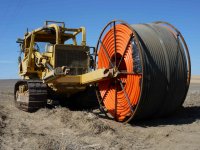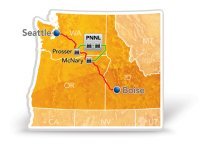Advanced Computing, Mathematics and Data
Research Highlights
March 2010
Backhoes Back Off!
PNNL secondary network connection now provides seamless data transfer

Installation of a secondary high speed connection from the Pacific Northwest National Laboratory to the world’s premiere research and education networks began in 2008 and was completed in late 2009. Enlarge Image

A new high-speed network intertie provides resiliency for the PNNL science network and uninterrupted data transfer to ESnet and other major research and educational networks. Enlarge Image
Jim Schroeder can now sleep easy. In November 2009, the Pacific Northwest National Laboratory IT engineer and his colleagues finished a secondary high speed connection to the world's premiere research and education networks. This includes the Department of Energy-sponsored ESnet, which serves DOE laboratories and collaborators worldwide.
"Before we had the new optical cable in place, we had only one physical path to these networks. Anyone with a backhoe could take us down between 2 hours and 2 days," said Schroeder, reminiscing about the nightmare of maintaining a single connection. "Now, the data transfer is seamless. A data stream can be switched automatically to the secondary line in less than a minute."
PNNL uses Dense Wavelength Division Multiplexing—DWDM—technology that allows a single fiber optic connection to carry multiple channels of data. Each channel uses a different color of light. The equipment currently installed is configured with 9 channels. Each channel can handle a 10 gigabit per second data stream. At full capacity, the PNNL system can handle 40 channels.
Reliable, speedy data transfer, with redundant connections, is crucial to the conduct of science, according to Kevin Regimbal, who manages PNNL's Scientific Data Management group. "In science, it's all about the data," he said as he explained that many research projects generate trillions of bytes, or terabytes, of data. "The transfer of a 1 terabyte data set over a 10-gigabit connection takes about 20 minutes. Compare that to over 3 hours to transfer that same data set over a typical network connection in an office setting and you can see the importance of a dependable, fast connection in conducting science," he said.
PNNL's story starts in 2005 when its first connection to the Pacific Northwest Gigapop, which provides a data service hub for regional, national and international networks, was completed. The 365-mile path starts in Richland, Washington, where the main PNNL campus is located, and goes south across the Columbia River to McNary, Oregon. Then, it hops back across the river and northwest to Yakima, Prosser, Cle Elum and ultimately Seattle where it connects to the Gigapop. This connection improved the Lab's data transfer rate from the previous 622 megabits via OC12 transmission to a total of 20 gigabits per second.
PNNL began the process of establishing a secondary connection to the network connecting Seattle and Boise in 2008. Working with Lockheed Martin Corporation, the City of Richland and the Benton County Public Utilities District, a new fiber optic cable was installed to a facility south of Prosser, Washington, to interconnect with a major fiber route between Seattle and Boise. The new connection, based out of EMSL, DOE's national scientific user facility at PNNL, established a second pathway from the Tri-Cities to Boise and Seattle, providing two independent pathways to the nation's premiere research and education networks.
"The new intertie through Prosser provides resiliency for problems that do occur when you have a single point equipment tie to the major data network in the region," said Schroeder. "The whole project has gone quite well. We'll see the benefit of a seamless data transfer many times in the future, I'm certain," he said.
The new configuration offers PNNL several pathway options for moving data between Richland, Seattle, and Boise. With 10 and 40 gigabit per second channel options available now, and a 100 gigabit option available soon, PNNL is poised to develop as data intensive computing grows. And Schroeder, well, he can dream without the IT terrors.
